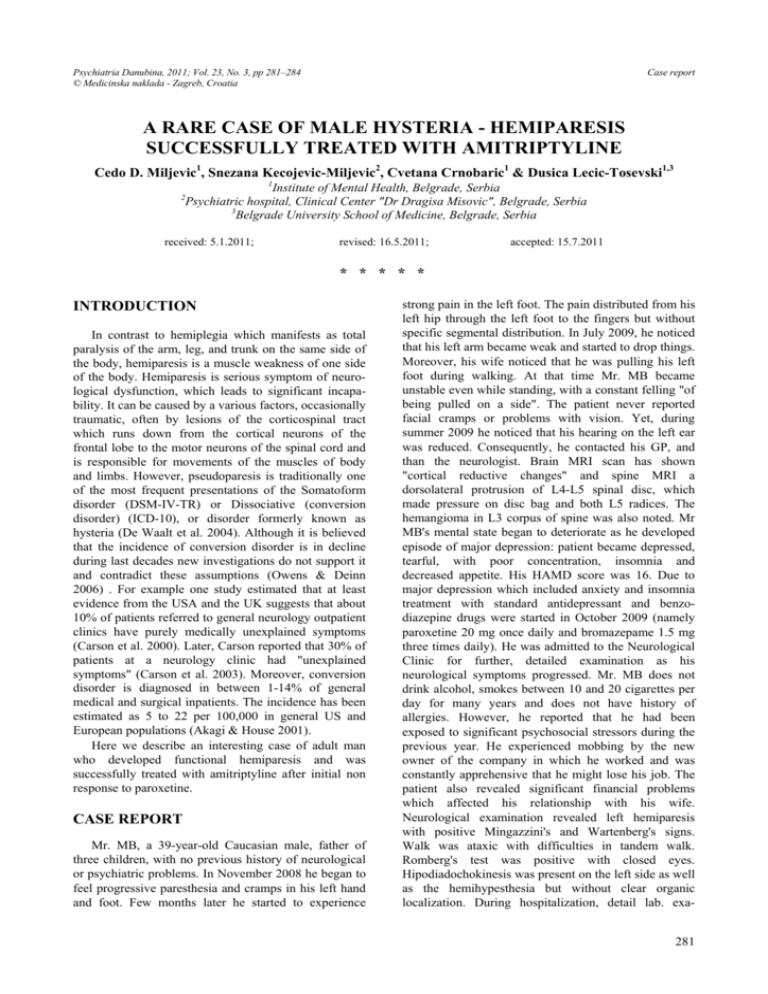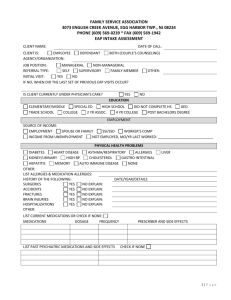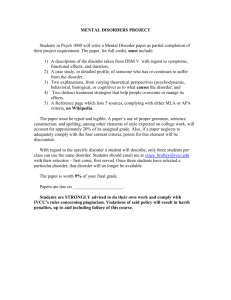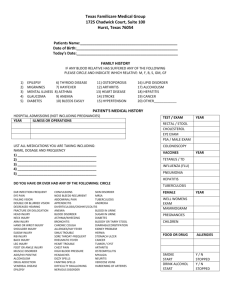A RARE CASE OF MALE HYSTERIA
advertisement

Psychiatria Danubina, 2011; Vol. 23, No. 3, pp 281–284 © Medicinska naklada - Zagreb, Croatia Case report A RARE CASE OF MALE HYSTERIA - HEMIPARESIS SUCCESSFULLY TREATED WITH AMITRIPTYLINE Cedo D. Miljevic1, Snezana Kecojevic-Miljevic2, Cvetana Crnobaric1 & Dusica Lecic-Tosevski1,3 1 Institute of Mental Health, Belgrade, Serbia Psychiatric hospital, Clinical Center "Dr Dragisa Misovic", Belgrade, Serbia 3 Belgrade University School of Medicine, Belgrade, Serbia 2 received: 5.1.2011; revised: 16.5.2011; accepted: 15.7.2011 * * * * * INTRODUCTION In contrast to hemiplegia which manifests as total paralysis of the arm, leg, and trunk on the same side of the body, hemiparesis is a muscle weakness of one side of the body. Hemiparesis is serious symptom of neurological dysfunction, which leads to significant incapability. It can be caused by a various factors, occasionally traumatic, often by lesions of the corticospinal tract which runs down from the cortical neurons of the frontal lobe to the motor neurons of the spinal cord and is responsible for movements of the muscles of body and limbs. However, pseudoparesis is traditionally one of the most frequent presentations of the Somatoform disorder (DSM-IV-TR) or Dissociative (conversion disorder) (ICD-10), or disorder formerly known as hysteria (De Waalt et al. 2004). Although it is believed that the incidence of conversion disorder is in decline during last decades new investigations do not support it and contradict these assumptions (Owens & Deinn 2006) . For example one study estimated that at least evidence from the USA and the UK suggests that about 10% of patients referred to general neurology outpatient clinics have purely medically unexplained symptoms (Carson et al. 2000). Later, Carson reported that 30% of patients at a neurology clinic had "unexplained symptoms" (Carson et al. 2003). Moreover, conversion disorder is diagnosed in between 1-14% of general medical and surgical inpatients. The incidence has been estimated as 5 to 22 per 100,000 in general US and European populations (Akagi & House 2001). Here we describe an interesting case of adult man who developed functional hemiparesis and was successfully treated with amitriptyline after initial non response to paroxetine. CASE REPORT Mr. MB, a 39-year-old Caucasian male, father of three children, with no previous history of neurological or psychiatric problems. In November 2008 he began to feel progressive paresthesia and cramps in his left hand and foot. Few months later he started to experience strong pain in the left foot. The pain distributed from his left hip through the left foot to the fingers but without specific segmental distribution. In July 2009, he noticed that his left arm became weak and started to drop things. Moreover, his wife noticed that he was pulling his left foot during walking. At that time Mr. MB became unstable even while standing, with a constant felling "of being pulled on a side". The patient never reported facial cramps or problems with vision. Yet, during summer 2009 he noticed that his hearing on the left ear was reduced. Consequently, he contacted his GP, and than the neurologist. Brain MRI scan has shown "cortical reductive changes" and spine MRI a dorsolateral protrusion of L4-L5 spinal disc, which made pressure on disc bag and both L5 radices. The hemangioma in L3 corpus of spine was also noted. Mr MB's mental state began to deteriorate as he developed episode of major depression: patient became depressed, tearful, with poor concentration, insomnia and decreased appetite. His HAMD score was 16. Due to major depression which included anxiety and insomnia treatment with standard antidepressant and benzodiazepine drugs were started in October 2009 (namely paroxetine 20 mg once daily and bromazepame 1.5 mg three times daily). He was admitted to the Neurological Clinic for further, detailed examination as his neurological symptoms progressed. Mr. MB does not drink alcohol, smokes between 10 and 20 cigarettes per day for many years and does not have history of allergies. However, he reported that he had been exposed to significant psychosocial stressors during the previous year. He experienced mobbing by the new owner of the company in which he worked and was constantly apprehensive that he might lose his job. The patient also revealed significant financial problems which affected his relationship with his wife. Neurological examination revealed left hemiparesis with positive Mingazzini's and Wartenberg's signs. Walk was ataxic with difficulties in tandem walk. Romberg's test was positive with closed eyes. Hipodiadochokinesis was present on the left side as well as the hemihypesthesia but without clear organic localization. During hospitalization, detail lab. exa281 Cedo D. Miljevic, Snezana Kecojevic-Miljevic, Cvetana Crnobaric & Dusica Lecic-Tosevski: A RARE CASE OF MALE HYSTERIA HEMIPARESIS SUCCESSFULLY TREATED WITH AMITRIPTYLINE Psychiatria Danubina, 2011; Vol. 23, No. 3, pp 281–284 mination, serological tests, electrophoresis, imunophoresis, lumbal punction, thyroid status, evoked potentials, otorhinolaryngology and electromyographic examination of the arm and leg, CT scan of the inner ear, echo scan of the abdomen and MRI scan of the cervical spine were performed. All the results were within the normal range. Consequently, all known causes of a hemiparesis were excluded - i.e. brain disorder, head injury, stroke, transient ischemic attack, brain injury, infective endocarditis, congenital brain malformations e.g. cerebral agenesis, cerebral palsy, cerebellar abscess, meningitis or associated various syndromes: Brushfield-Wyatt and Klippel-Feil syndrome, brain compression, demyelization disorder, Moya Moya disease, Sturge-Weber syndrome etc. The patient was discharged after one month with the diagnosis of left functional hemiparesis, and with suggestion to continue psychiatric treatment. After two months of treatment insufficient response to paroxetin/bromazepam treatment were noted so patient was switched to amitriptyline 25 mg three times daily and lorazepam 1 mg three times daily. This drugs were chosen on the basis of different mechanism of action (dual action of amitriptyline on monoamine reuptake transporters) and stronger activity (lorazepame). One month later, significant improvement in the patient's mood was noted. Moreover, hemiparesis as well as hemiparesthesia subsided. No adverse events of drugs were noted. Patient had never been psychologically treated. Presently, the patient is euthymic and without neurological complaints: He has successfully returned to his job. He is being regularly monitored at the Psychiatric Outpatient Clinic, and is still on the same psychotropic medications. DISCUSSION Conversion disorder is defined by DSM-IV-TR as a mental disorder whose central feature is the appearance of symptoms affecting the patient's senses or voluntary movements that suggest a neurological or general medical disease or condition. Yet, following a thorough evaluation no neurologic explanation exists for the symptoms. In other words conversion disorder is a type of somatoform disorder where physical symptoms or signs are present that cannot be explained by a medical condition (Allin et al. 2005). Our patient had almost all known factors which are believed to be associated with conversion disorder. In terms, of clinical presentation the pseudoparalysis is one of the most frequently encountered symptoms in patient population. Ever since the late 19th century observers have commented that hysterical hemianesthesia and hemiplegia tend to be seen more commonly on the left than the right side of the body (Purves-Stewart 1924). It was suggested that the right hemisphere has a particular role in emotional processing, making it more likely to 282 mediate affectively determined symptoms (Stern 1977). Recently Stone et al (Stone et al. 2003) confirmed previous findings and reported a significant increase in the incidence of symptoms on the left side of the body (58% of patients). Moreover, although majority of cases had an acute onset, gradual worsening of symptoms may occur as it was the case in our patient. Conversion disorder is reported to be more common in rural population, in individuals with lower socioeconomic status, lack of education, and low psychological sophistication (Hales et al. 2008). However, a major difference exists between the prevalence in developing and developed countries. In former countries the prevalence of conversion disorder may run as high as 31% and Serbia is a developing country. The onset of the symptoms is often preceded by conflicts or stressors in a patient's life such as loss of employment or divorce. In the adult population, conversion disorder may be associated with mobbing. Moreover, studies have shown high comorbidity of somatoform disorders and anxiety or depressive disorders (Lieb et al. 2007). Anxiety and depression are the most commonly reported psychiatric comorbidities among patients with conversion disorder. Earlier studies showed that 15.7-32.0% of patients with conversion disorder also had major depression; and 24.0-37.2% of patients with conversion disorder had anxiety disorder (Pehlivanturk et al. 2000, Khan et al. 2005, Kozlowska et al. 2007). Study done in the Netherlands seems to show a correlation between conversion disorder and anxiety and depression disorders. Of all patients with a somatoform disorder, 26 appeared to also have an anxiety or depressive disorder, and 54 percent of patients with an anxiety or depressive disorder seemed to also have a somatoform disorder (De Waal et al. 2004). However the sample size was small and further studies are needed to corroborate their assertions Conversion disorders (e.g., hysteria) historically have been associated with women. Most studies in adults, including contemporary series, continue to report a predominance of the disorder in women. with reported ratios varying from 2:1 to 10:1. Women (rarely men) presenting with conversion symptoms may later manifest the full picture of Somatization Disorder. In men, there is an association between Conversion Disorder and Antisocial Personality Disorder (Wilson et al. 1988). Studies suggest that several variables, including genetic, physiological and psychosocial factors such as socialization process and cultural factors, contribute to sex differences in conversion disorder. The predominant cultural emphasis, for example, has led to greater social acceptability of women who show discomfort than of men. Additionally, illness-reporting and help-seeking behaviors, different responsibilities on the basis of gender roles, and role strains do play critical roles (Huang et al 2009.). However, in one tertiary care setting, approximately the same number of men as Cedo D. Miljevic, Snezana Kecojevic-Miljevic, Cvetana Crnobaric & Dusica Lecic-Tosevski: A RARE CASE OF MALE HYSTERIA HEMIPARESIS SUCCESSFULLY TREATED WITH AMITRIPTYLINE Psychiatria Danubina, 2011; Vol. 23, No. 3, pp 281–284 women had conversion disorder (Crimlisk et al. 1998). Certain settings, such as the military or disability evaluations, may include a majority of men (Allodi 1974; Carden and Schramel 1966; Weinstein et al. 1969). Conversion in children is equally divided among boys and girls (Maloney 1980). There is little evidence to guide pharmacotherapy in conversion disorder, and specific guidelines available at present. The clinical evidence for pharmaco-therapy in conversion disorder is extremely limited and consists of case reports. Generally, the initial aim in treating conversion disorder is the removal of the symptoms. After physical illness is excluded prognosis for conversion symptoms is good (Folks et al. 1984.). Anecdotal reports exist of positive response to somatic treatments such as phenotiazines, lithium and even electroconvulsive therapy. In other it may be that symptoms removal occured because of resolution of another psychiatric disorder, especially a mood disorder. Patients with conversion disorder commonly demonstrate physiological and psychological medication hypersensitivity characterized by unusual side effects, in part linked to their reluctance to accept that they have a psychiatric disorder. Therefore medications need to be applied at low dosages and gradually titrated upwards (Hurwitz 2003). A large proportion of patients with conversion have been found to have underlying depression. Effective treatment of the underlying depression may resolve the conversion symptom (Cybulska 1997). Moreover, Bourgeois et al. (2002) and Hurwitz (2004) showed that even without a diagnosable mood disorder, antidepressants may be helpful. Our patient's symptoms resolved after treatment with amitriptyline but not after treatment with paroxetine. Several studies have shown that some TCAs may be more effective than SSRIs in depressed inpatients, with the strongest evidence for amitriptyline (Barbui et al. 2004). TCAs have an important place as the first-line treatment for patients with severe (melancholic/endogenous) depression (Boyce & Judd 1999.). However, this issue remains controversial and is not resolved yet. Machado et al. (2006) have reported that remission rate for TCAs (44.1%) is higher than for SSRIs (37.7%). Systematic review (Anderson 1998) including 25 studies with a total of nearly 1400 subjects has shown that TCAs were significantly more effective than SSRIs. Of importance for this case report is notion that only the dual action TCAs had greater efficacy than SSRIs. Recently Barbui et al. (2001) have shown that randomized trials suggest that amitriptyline probably has the edge in terms of efficacy over SSRIs. CONCLUSION Conversion disorder might not be as uncommon as perceived by psychiatrists today. The presence of dramatic manifestation of symptoms, risk factors, the course of the disorder and the patient's response to a tricyclic antidepressant point to an unusual presentation of this case. Further research is required to investigate the efficacy of different treatment options for this disorder. REFERENCES 1. Akagi J, House A: The epidemiology of hysterical conversion. In: Halligan PW, Bass CM, Marshall JC, eds. Contemporary approaches to the study of hysteria. Oxford, UK: Oxford University Press; 2001. pp. 73-87. 2. Allin M, Streeruwitz A, Curtis V: Progress in understanding conversion disorder. Neuropsychiatric Diseases Treatment 2005; 1:205-9. 3. Allodi FA: Accident neurosis: whatever happened to male hysteria? Can J Psychiatry 19:291-296, 1974. 4. Anderson IM: SSRIs versus tricyclic antidepressants in depressed inpatients: a meta-analysis of efficacy and tolerability. Depression and Anxiety 1998; 7(suppl 1):1117. 5. Barbui C, Guaiana G, Hotopf M: Amitriptyline for inpatients and SSRIs for outpatients with depression? Systematic review and meta-regression analysis. Pharmacopsychiatry 2004; 37:93-7. 6. Barbui C, Hotopf M: Amitriptyline vs rest: still the leading antidepressant after 40 years of randomised controlled trials. British Journal of Psychiatry 2001; 178, 129-44. 7. Bourgeois JA, Chang CH, Hailty DM, et al Vlinicsal manifestation and management of conversion disorders. Curr Treat Options Neurol 4:487-49. 2002. 8. Boyce P, Judd F: The place for the tricyclic antidepressants in the treatment of depression. Australia New Zealand Journal of Psychiatry 1999; 33:323-7. 9. Carden NL, Schramel DJ: Observations of conversion reactions seen in troops involved in the Vietnam conflict. Am J Psychiatry 123:21-31, 1966. 10. Carson AJ, Best S, Postma K, Stone J, Warlow C, Sharpe M The outcome of neurology outpatients with medically unexplained symptoms: a prospective cohort study. Journal of Neurology, Neurosurgery and Psychiatry 2003; 74: 897-900. 11. Carson AJ, Ringbauer B, Stone J, McKenzie L, Warlow CP, Sharpe M Do medically unexplained symptoms matter? A prospective cohort study of 300 new referrals to neurology outpatient clinics. Journal of Neurology, Neurosurgery and Psychiatry 2000; 68:207-10. 12. Crimlisk HL, Bhatia K, Cope H, et al: Slater revisited: six year follow-up study of patients with medically unexplained motor symptoms. BMJ 316:582-586, 1998. 13. Cybulska EM: Globus hystericus-a somatic symptom of depression? The role of electroconvulsive therapy and antidepressants. Psychosom Med 59:67-69, 1997. 14. De Waal M.W.M, Arnold I.A, Eekhof J.A.H, Van Hemert A.M. Somatoformdisorders in general practice Prevalence, functional impairment and comorbidity with anxiety and depressive disorders. British Journal of Psychiatry; 2004; 184:470-476. 15. De Waalt MWM, Arnold IA, Eekhof JAH, Van Hemert AM: Somatoform disorders in general practice: Prevalence, functional impairment and comorbidity with anxiety and depressive disorders. British Journal of Psychiatry 2004; 184:470-76. 283 Cedo D. Miljevic, Snezana Kecojevic-Miljevic, Cvetana Crnobaric & Dusica Lecic-Tosevski: A RARE CASE OF MALE HYSTERIA HEMIPARESIS SUCCESSFULLY TREATED WITH AMITRIPTYLINE Psychiatria Danubina, 2011; Vol. 23, No. 3, pp 281–284 16. Hales RE, Yudofsky SC, Gabbard GO: Somatoform Disorders. In: Hales RE, Yudofsky SC, Gabbard GO (eds). The American Psychiatric Publishing Textbook of Psychiatry.5th. American Psychiatric Publishing, Inc. 2008 pp 624-30. 17. Huang KL, Su TP, Lee YC, Bai YM, Hsu JW, Yang CH, Chen YS: Sex Distribution and Psychiatric Features of Child and Adolescent Conversion Disorder Across 2 Decades. J Chin Med Assoc 2009; 72:471-477. 18. Hurwitz TA Somatization and conversion disorder. Can J Psychiatry 49; 172-178, 2004. 19. Khan MN, Ahmad S, Arshad N, Ullah N, Maqsood N. Anxiety and depressive symptoms in patients with conversion disorder. J Coll Physicians Surg Pak 2005; 15:489-92. 20. Kozlowska K, Nunn KP, Rose D, Morris A, Ouvrier RA, Varghese J. Conversion disorder in Australian pediatric practice. J Am Acad Child Adolesc Psychiatry 2007; 46:68-75. 21. Lieb R, Meinlschmidt G, Araya R: Epidemiology of the association between somatoform disorders and anxiety and depressive disorders: An update. Psychosomatic Medicine 2007; 69:860-63. Correspondence: Cedo D. Miljevic, MD, PhD Institute of Mental Health Palmoticeva 37, 11 000 Belgrade, Serbia E-mail: cedo.miljevic@yahoo.com 284 22. Machado M, Iskedjian M, Ruiz I, Einarson TR: Remission, dropouts, and adverse drug reaction rates in major depressive disorder: a meta-analysis of head-to-head trials. Current Medical Research Opinion 2006; 22:1825-37. 23. Maloney JH: Diagnosing hysterical conversion reactions in children. J Pediatr 97:1016-1020, 1980. 24. Owens C, Dein S: Conversion disorder: the modern hysteria. Advances in Psychiatric Treatment 2006; 12: 152-57. 25. Pehlivanturk B, Unal F. Conversion disorder in children and adolescents: clinical features and comorbidity with depressive and anxiety disorders. Turk J Pediatr 2000; 42:132-7. 26. Purves-Stewart J: The diagnosis of nervous diseases. London: Butler and Tamner. 1924. 27. Stern DB: Handedness and the lateral distribution of conversion reactions. Journal of Neurology, Neurosurgery and Psychiatry 1977; 164: 122-8. 28. Stone J, Sharpe M, Rothwell PM, Warlow, C P The 12 year prognosis of unilateral functional weakness and sensory disturbance. Journal of Neurology, Neurosurgery and Psychiatry 2003; 74: 591-6. 29. Weinstein EA, Eck RA, Lyerly OG: Conversion hysteria in Appalachia. Psychiatry 32:334-341, 1969.




